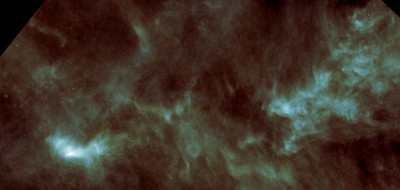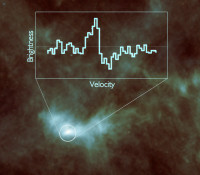Large water reservoirs at the dawn of stellar birth
9 October 2012
ESA's Herschel space observatory has discovered enough water vapour to fill Earth's oceans more than 2000 times over, in a gas and dust cloud that is on the verge of collapsing into a new Sun-like star.
 |
|
Taurus molecular cloud. Credit: ESA/Herschel/SPIRE |
Stars form within cold, dark clouds of gas and dust – 'pre-stellar cores' – that contain all the ingredients to make solar systems like our own.
Water, essential to life on Earth, has previously been detected outside of our Solar System as gas and ice coated onto tiny dust grains near sites of active star formation, and in proto-planetary discs capable of forming alien planetary systems.
The new Herschel observations of a cold pre-stellar core in the constellation of Taurus known as Lynds 1544 are the first detection of water vapour in a molecular cloud on the verge of star formation.
More than 2000 Earth oceans-worth of water vapour were detected, liberated from icy dust grains by high-energy cosmic rays passing through the cloud.
 |
|
Water in L1544. Credit: ESA/ Herschel/SPIRE/HIFI/Caselli et al. |
"To produce that amount of vapour, there must be a lot of water ice in the cloud, more than three million frozen Earth oceans' worth," says Paola Caselli from the University of Leeds, UK, lead author of the paper reporting the results in Astrophysical Journal Letters.
"Before our observations, the understanding was that all the water was frozen onto dust grains because it was too cold to be in the gas phase and so we could not measure it.
"Now we will need to review our understanding of the chemical processes in this dense region and, in particular, the importance of cosmic rays to maintain some amount of water vapour."
The observations also revealed that the water molecules are flowing towards the heart of the cloud where a new star will probably form, indicating that gravitational collapse has just started.
"There is absolutely no sign of stars in this dark cloud today, but by looking at the water molecules, we can see evidence of motion inside the region that can be understood as collapse of the whole cloud towards the centre," says Dr Caselli.
"There is enough material to form a star at least as massive as our Sun, which means it could also be forming a planetary system, possibly one like ours."
Some of the water vapour detected in L1544 will go into forming the star, but the rest will be incorporated into the surrounding disc, providing a rich water reservoir to feed potential new planets.
"Thanks to Herschel, we can now follow the 'water trail' from a molecular cloud in the interstellar medium, through the star formation process, to a planet like Earth where water is a crucial ingredient for life," says ESA's Herschel project scientist, Göran Pilbratt.
Notes for Editors
"First detection of water vapour in a pre-stellar core," by P. Caselli et al. has been accepted for publication in Astrophysical Journal Letters.
Herschel studied the dark cloud L1544 as part of the Water in Star-forming regions with Herschel (WISH) key programme using the Heterodyne Instrument for the Far-Infrared spectrometer (HIFI) on Herschel. Herschel is an ESA space observatory with science instruments provided by European-led Principal Investigator consortia and with important participation from NASA. HIFI was designed and built by a nationally funded consortium led by SRON Netherlands Institute for Space Research. The consortium includes institutes from France, Germany, USA, Canada, Ireland, Italy, Poland, Russia, Spain, Sweden, Switzerland and Taiwan.
For further information, please contact:
Markus Bauer
ESA Science and Robotic Exploration Communication Officer
Tel: +31 71 565 6799
Mob: +31 61 594 3 954
Email: markus.bauer![]() esa.int
esa.int
Paola Caselli
University of Leeds
Email: p.caselli![]() leeds.ac.uk
leeds.ac.uk
Göran Pilbratt
ESA Herschel Project Scientist
Tel: +31 71 565 3621
Email: gpilbratt![]() rssd.esa.int
rssd.esa.int
(This article was originally published on ESA's Space Science Portal.)


